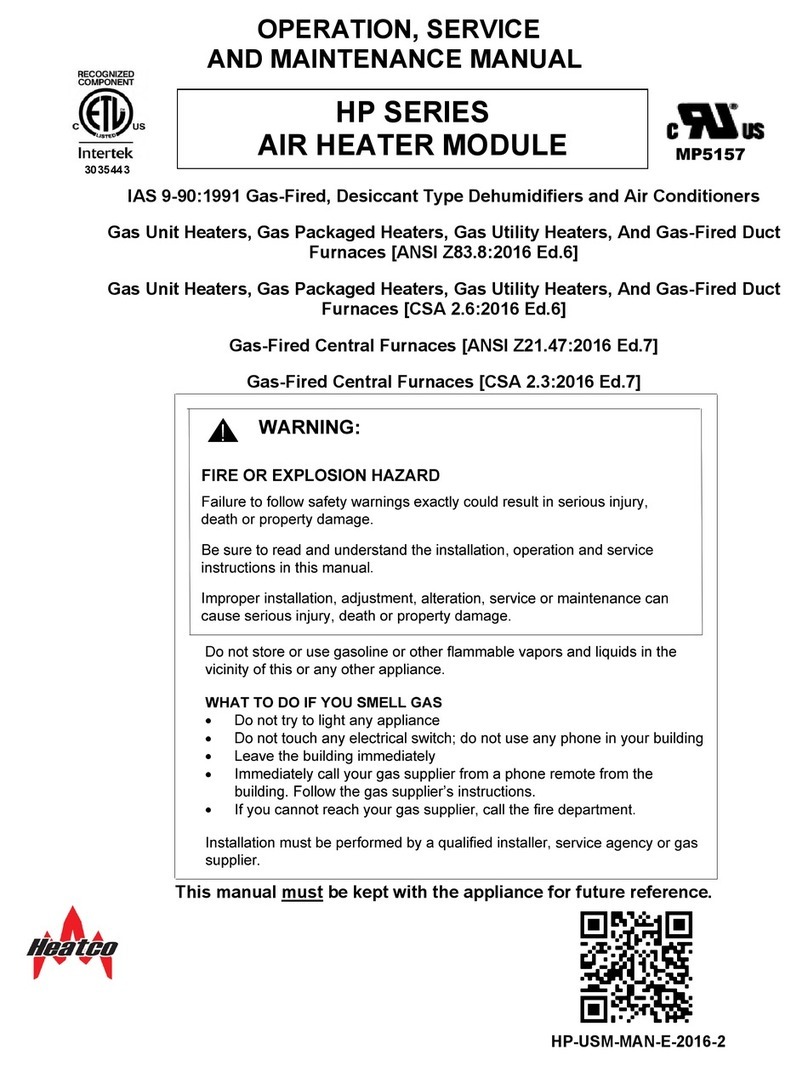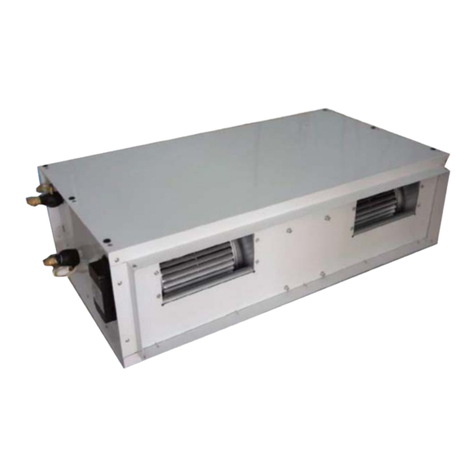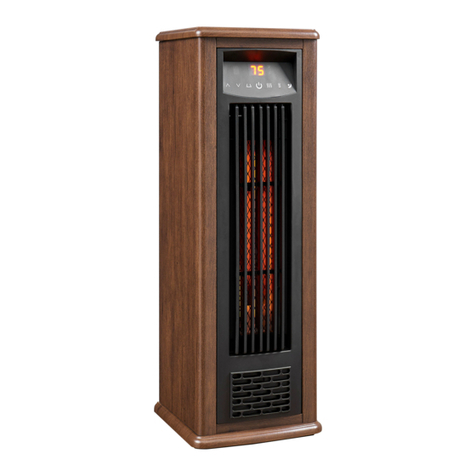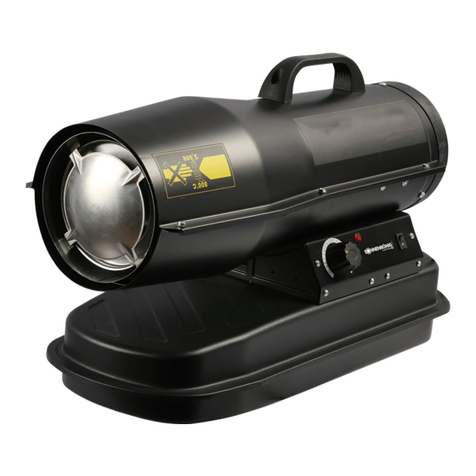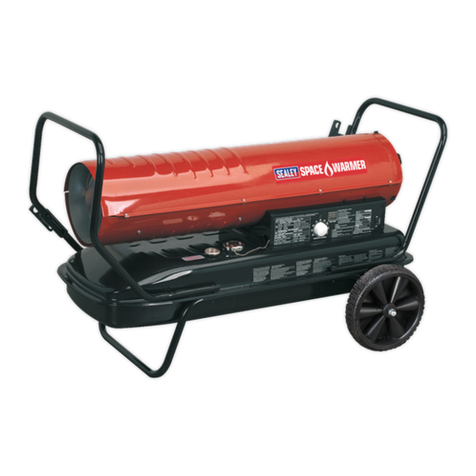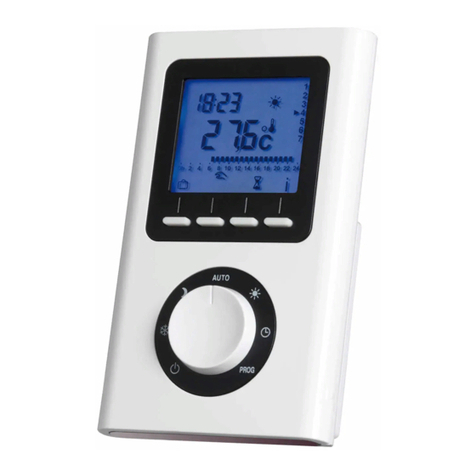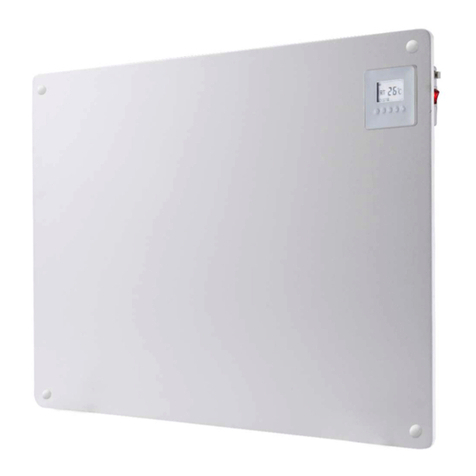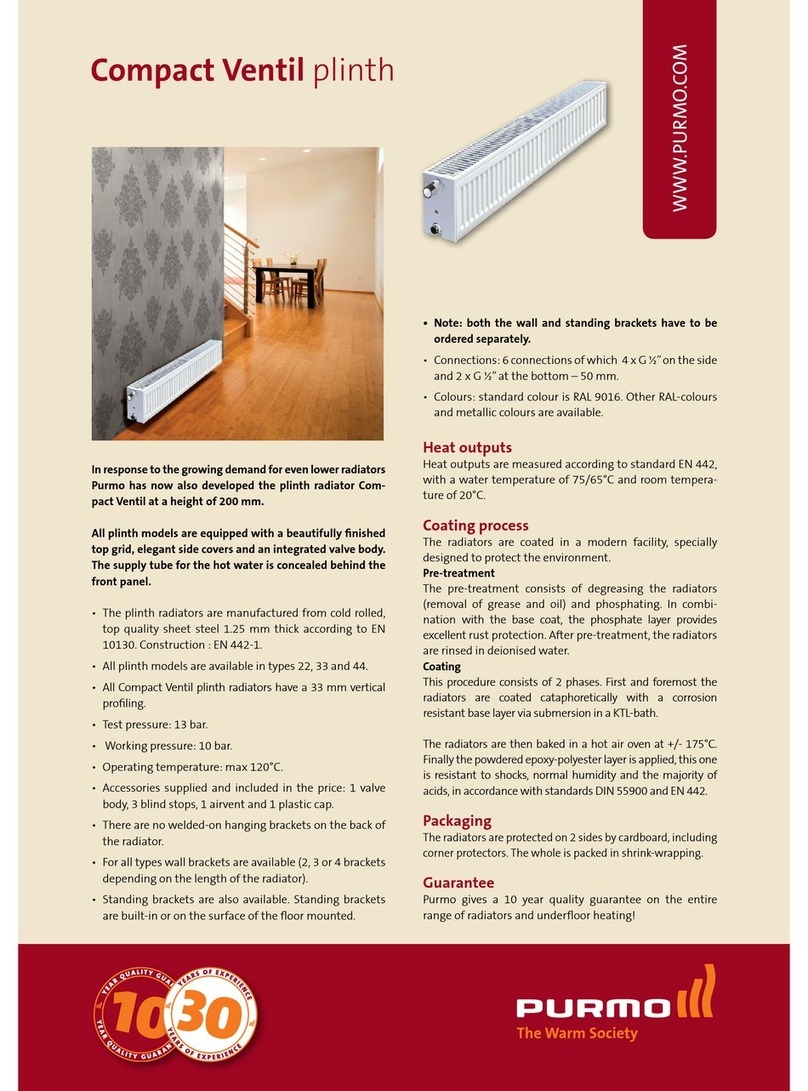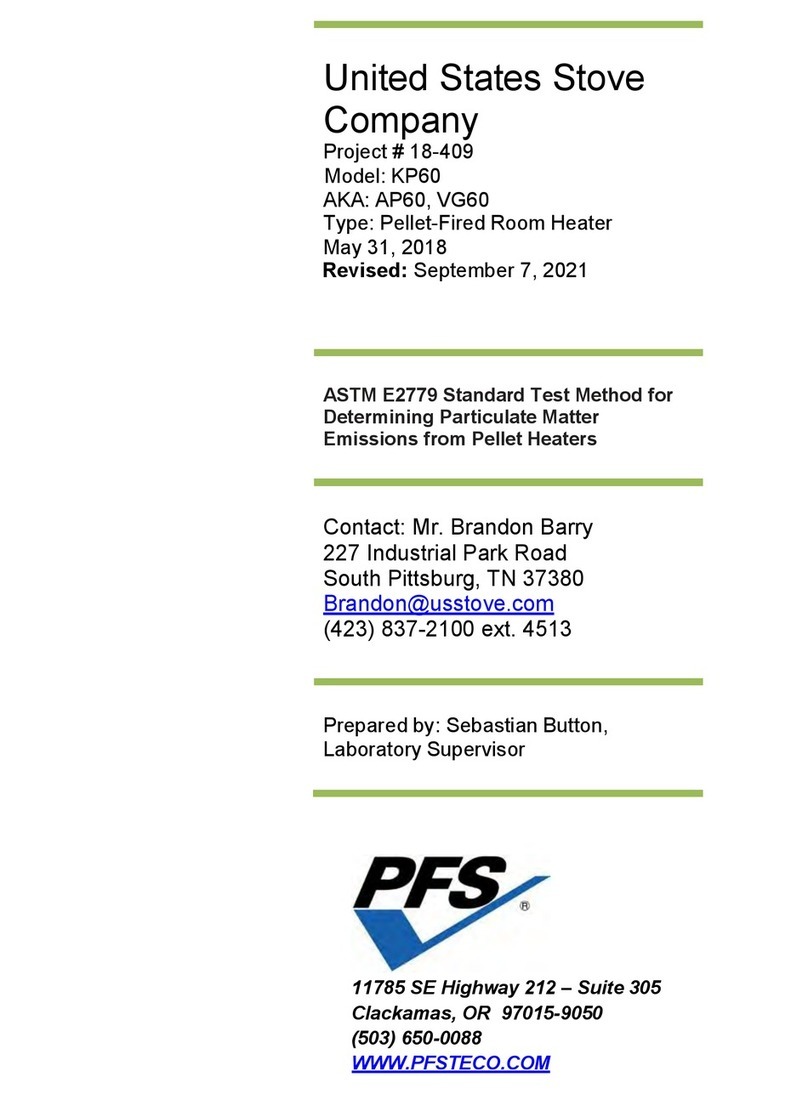heatco DF Series User manual

1
OEM INSTALLATION INSTRUCTIONS
ANSI Z83.25 (2017) –CSA 3.19 (2017)
Direct gas-fired process air heaters
DF Series Modules are a Recognized Furnace Component
Design Certified by both Intertek Testing Services (ITS / ETL)
and Underwriters Laboratories (UL)
For Indoor or Outdoor Installation
This Product is intended for installation by Original Equipment Manufacturers
Of Listed Heating Equipment in duct or cabinet mounted applications
on the Negative pressure side of the circulating air blower.
The direct gas-fired heater modules covered by these instructions become a component
of a “Listed” product, subject to the guidelines of application provided in these
instructions and as designated by the Certifying Agency in the Manufacturer’s Listing Procedure
Manufactured by:
Heatco Inc
50 Heatco Court
Cartersville, Ga. 30120DF-OEM-MAN-LIST-Z83.25-1
DF Series
Direct Gas-Fired Heater Modules

2
Inspection on Arrival
This direct gas-fired heater module was test fired and inspected at the factory prior to crating and was in satisfactory working
order. A copy of the Test and Inspection sheet is included in the information package provided. Inspect the packaging on delivery
for any signs of damage. Report any damage immediately to the transporting agency. After uncrating inspect direct gas-fired
heater module for any concealed damage.
Table of Contents
I. General Instructions for DF Series Modules. . . . . . . 3
II. General Information to include in Installation and Operating Instructions. . . 3 - 4
III. Direct-Fired Heat Module Application. . . . . . . 4 –5
IV. Paint Booth Application. . . . . . . . . 6
V. Airflow Distribution & Multiple Heaters Application. . . . . . 6
VI. Cabinet Installation Guidelines. . . . . . . . 7
VII. Temperature Limit and Airflow Proving Switch. . . . . . 7
VIII. Circulating Air Supply. 8
IX. Burner Air Pressure Differential Adjustment . . . . . . 8
X. Maximum / Minimum Airflow (VAV). . . . . . . . 9 - 10
XI. Gas Supply, Piping and Connections. . . . . . . 10 - 11
XII. Direct Gas-Fired Heat Module Controls. . . . . . . 12
XIII. Electrical Controls & Wiring.. . . . . . . . 12 - 13

3
I. General Instructions for DF Series Direct Gas-Fired Modules
This product MUST BE INSTALLED IN A NON-COMBUSTIBLE cabinet. See clearance to combustibles on
ratings label.
This product is intended to be installed upstream of any cooling coils.
A Nameplate / Rating Plate is attached to the direct gas-fired heater module to identify the model and serial
number of this product. This plate must be left attached when the module is installed in the end product for
identification purposes. This plate also contains information including gas type, maximum and minimum input rating,
manifold pressure, maximum and minimum inlet gas pressure, maximum and minimum airflow requirements, and
electrical ratings for this module.
The final determination of the safety and suitability of this product for the specific application shall be the
responsibility of the manufacturer of the “Listed” equipment and the listing Agency.
This product must be applied in accordance with the requirements of the listed product in which it is installed.
Consider maximum input ratings, maximum and minimum temperature rise and maximum and minimum airflow.
Equipment access panels and doors should be sized and located to provide easy access for servicing, adjustment
and maintenance of the direct gas-fired units installed. Consideration should be given to components that might
require replacement during the life of the product. All set-up and test points as well as operating controls should be
visible and readily accessible from the front of the vestibule or access opening.
II. General Information to include in Installation and Operating Instructions
The “Listed” equipment manufacturer’s Installation and Operating Instructions shall provide all necessary
information, instructions and labels as required by ANSI Z83.25 –CSA 3.19 Standard for Non-recirculating Direct
Gas-fired and Forced Ventilation Appliances for Commercial and Industrial application.
Reference to the following information must be included in the instructions that the OEM provides with the finished
product.
oAll unit installations shall conform to all applicable local codes and ordinances, or in the absence of local codes
must be in accordance with the National Fuel Gas Code ANSI Z223.1 (NFPA 54) in the US and Can/CGA-
B149.1 Natural Gas and Propane Installation Code in Canada..
oFor module(s) to be installed in an airplane hangar, refer to ANSI/NFPA 409. For module(s) to be installed in a
parking garage, refer to ANSI/NFPA 88A. For module(s) to be installed in a service garage, refer to ANSI/NFPA
88B.
oA WARNING that the direct gas-fired heater modules are not designed for use in hazardous atmospheres
containing, flammable vapors or combustible dust, in atmospheres containing chlorinated or halogenated
hydrocarbons, or in applications with airborne substances containing silicone.
oA WARNING: The use and storage of gasoline or other flammable vapors and liquids in the vicinity of this
appliance is hazardous.
oWARNING labels attached to exterior of cabinet as required by ANSI Z83.25 –CSA 3.19.
oSafety, lighting, operating and shutdown instructions.
oAn electrical disconnect switch having adequate ampacity (See heater marking for voltage and ampacity), if not
provided as part of heater module assembly, shall be installed in accordance with Article 430 of the National
Electric Code, ANSI/NFPA 70. All electrical equipment must be grounded and wired be in accordance with
NFPA 70 in the US and the Canadian Electric Code (CSA C22.1) in Canada.
oA statement to cover replacement wiring “If any original wire as supplied with the appliance must be
replaced, it must be replaced with wiring material having a temperature rating of at least 105 oC (221
oF).”

4
Additionally, the Original Equipment Manufacturer of the “Listed” equipment shall provide the following in
accordance with its product listing:
An enclosed vestibule area to house and protect gas controls, burner assemblies, gas trains, and electrical controls
from direct water spray, rain or dripping water.
An airflow switch in the cabinet or duct to prove circulating airflow. The device should prevent operation of the gas
heater in the event of failure of the circulating air fan. An airflow probe should be installed upstream of the heating
section (See Figure 1).
A manual reset temperature limit to prevent overheating of the heating unit in the event of improper operation, a
circulating air fan failure, low airflow conditions due to filter blockage, coil blockage and or damper failure. (See Figure
1 for location)
Removable access panels or access doors in cabinet or duct immediately upstream and downstream of duct
furnace to allow for inspection of the direct-fired gas burners. These openings should be large enough to observe
the burners in their entirety. Attach covers so as to prevent air leakage.
Clearances to combustibles as appropriate for the product category, but in no case less than the following unless
determined by test as part of the manufacturer’s equipment listing:
▪Sides .…………………………………. 8 in. (203mm)
▪Bottom ………………………………… 6 in. (152mm)
▪Top ……………………………………. 10 in. (254mm)
It is up to manufacturer to test these clearances in the end product to verify proper dimensions.
III. Direct-Fired Heat Module Application
Figure 1 –Typical Pull-Thru Installation
When the heater is operated as a process air heater in a paint booth application or other applications with
airborne particulate matter that could be detrimental to the operation of the heater in the recirculating mode,
the recirculated air must be filtered to remove particulates from the air.
Filters must be installed in the return air duct system and have the means to facilitate inspection, maintenance,
cleaning, and access to fire protection devices.
Filters are required upstream of the direct gas-fired burner assembly. Particulate removal filters are not provided by
Heatco and must be approved by the authority having jurisdiction.

5
Minimum distance between the burner and blower should ensure proper stratification of the combustion air. Uniform
airflow MUST be directed over the profile plate opening.
The direct gas-fired heater module must be installed to fire with, and parallel to, the air flow.
The burner performance is dependent on its application and installation in the air handler. Manufacturer
does not guarantee combustion results prior to performing actual combustion tests. The supply fan is positioned to
draw air across the burner. The burner is designed to operate on 100% outside (fresh) air. Airflow across the burner
must be laminar and velocity must be within the specified range to insure desired capacity and turndown.
The direct gas-fired heater module profile plate mounting rails and profile plate sheet metal must be securely
fastened in the ductwork or cabinet. Provisions should be made so that downstream materials within 40” to 60” are
rated for at least 300oF.
The direct-fired heat module should be centered with the circulating air blower.
The heat module must be sheeted off to provide an air tunnel properly sized to direct airflow over the
burner, profile plate and optional dampers to eliminate unwanted by-pass air, as shown in Figure 2.
Figure 2 –Heat Module Air Tunnel
If air tunnel opening is larger than module profile, provide panels to block by-pass air and direct all airflow
over the designed burner, profile plate, and optional dampers as shown in Figure 3.
Figure 3 –Air Tunnel

6
IV. Paint Booth Application
In a paint booth application, an interlock shall be installed in the field to lock out the paint spraying equipment unless
the process heater is operated in the ventilation air mode. The customer safety interlock should be wired in series
with the heat enable signal. See supplied wiring diagram.
An interlock shall be installed in the field so that when the heater is operated in the ventilation air mode for an
minimum of three (3) minutes at the start of the bake or drying cycle with the paint spraying equipment locked out.
The purge period is field adjustable by setting the Time delay relay purge (TDRP) on the heater module control.
An interlock shall be installed in the field to initiate the operation of the heater fan in conjunction with the operation of
the exhaust fan. This interlock is provided by others and may be validated by an air flow proving switch. An air flow
proving switch should be wired in series with the heat enable and other customer safety interlocks.
V. Airflow Distribution & Multiple Heaters Application
Selection of direct gas-fired heater modules to provide desired conditions requires careful consideration of
necessary discharge air temperature, airflow (volume), airflow (direction), pressure drop across burners, air tunnel
dimensions and module configurations. Modules may be installed individually or in parallel. Refer to examples in
Figure 4 for suggested configurations. The maximum allowable discharge air temperature is 160 oF for direct gas-
fired heater module,
Figure 4 –Recommended Heater Installations
Single Unit –Side View
Parallel Unit –Side View
19841 CFM
45 oF Entering
Air Temp
1,100,000 Btuh
Input
45 oF Rise
90 oF
Discharge
Air Temp
1,100,000 Btuh
Input
45 oF Rise
39682 CFM
45 oF Entering
Air Temp
mp
90 oF
Discharge
Air Temp
Design Pressure Drop 0.6”
w.c.
Design Pressure Drop 0.6” w.c.
Based on equal airflow of 19841
cfm thru each section
1,100,000 Btuh
Input
45 oF Rise

7
VI. Cabinet Installation Guidelines
Verify the following before installing the direct gas-fired heater module:
1. Electrical supply and gas supply match ratings and gas type marked on the direct gas-fired heater module
rating plate before installing the module.
2. Direct gas-fired heater module is installed in orientation marked on vestibule. Orientation is specific to airflow
direction through the burners of the direct gas-fired heater module.
3. Direct gas-fired module section must be installed in a non-combustible duct or cabinet.
Carefully support and lift module into position and slide into cabinet. Provide proper support or rigging using vest
panel and profile plate support brackets to support module during installation into cabinet. Fasten to cabinet.
The following must be included as part of the installation in the heating unit:
1. An air flow proving switch wired to prove operation of the correct system circulating air blower capacity.
2. A Manual Reset Temperature Limit to shut-off heater in the event of low airflow conditions due to filter
blockage, coil blockage and or damper failure.
3. Electrical control panels mounted away from heated surfaces.
4. Completed electrical connections from direct gas-fired heater module to the control panel.
5. Properly supported wiring in vestibule area. Wiring should not contact metal surfaces which may be hot
during direct gas-fired heater module operation.
6. Pipe sealant resistant to LP gases on all thread gas connections.
7. For gas regulators located indoors and not equipped with vent limiters, a properly sized vent to the outdoors.
8. Properly sized and located equipment access panels and doors to provide easy access for servicing, adjustment
and maintenance of the heating units installed.
VII.Temperature Limit and Airflow Proving Switch
An airflow proving switch and manual reset temperature limit must be installed in the duct direct gas-fired
heater module application.
The airflow proving switch prevents operation of the gas direct gas-fired heater module in the event of failure or
restriction of the circulating air fan. The airflow probe should be installed upstream of the heating section (See Fig.
1) to detect a negative pressure. The airflow switch would open the heat enable circuit to the flame safeguard
control if the correct minimum pressure is not detected by the switch. An airflow proving switch kit is available for this
module.
A manual reset temperature limit provides additional protection from overheating of the appliance or air handler in
the event of improper operation or a circulating air fan failure. Under such conditions the integral primary high limit
would cycle the heater resulting in heat build-up and possible damage to the module or appliance. A properly
located temperature limit is critical (See Fig. 1). The temperature limit will function to shut-off the gas supply to the
burners by opening the temperature safety circuit to the flame safeguard control.
WARNING !
Do not use burners, gas train, or manifold pipe as load bearing support during handling or
installation of direct gas-fired heater module in cabinet. Severe damage may result to burners,
profile plate, gas train, or pilot line assembly that result in unsafe operation, severe personal
Injury, death or significant property damage.

8
VIII. Circulating Air Supply
DF Series Direct gas-fired heater modules should ALWAYS be installed with burners in parallel with the
circulating airflow direction.
The circulating air is to be uniform across the full length of profile plate opening.
The direct gas-fired module is designed to operate with all circulating air passing over the burners taken
directly from outdoors.
IX. Burner Air Pressure Differential Adjustment
The direct gas-fired heater modules have an ideal standard design airflow condition of 2850 fpm and a flame length
of 15” at high fire (full input capacity 550 MBtuh per foot of burner) with 70 oF air.
Proper air velocity over the burner is critical to satisfactory operation of direct gas-fired units. If air velocity is not
within specifications, the unit may not operate efficiently or maintain satisfactory combustion emissions levels. To
obtain the desired operating condition, the proper pressure differential across the burner should be set as follows:
•Natural Gas: 0.60 in. w.c. (+/- .02”)
•Propane Gas: 0.75” in. w.c. (+/- .02”)
Connect a manometer to the burner differential pressure sensing probes (See Fig. 7) to measure the pressure drop
across the burner.
Adjust circulating air fan RPM with adjustable motor sheaves or VFD (if equipped) to achieve proper pressure drop.
Be sure motor amp draw does not exceed motor nameplate Full Load amperage (FLA).
Burner profile plates come with manually adjustable air baffles. These baffles may be used in the field at final
installation to optimize the circulating air velocity and pressure drop across the burners. The profile plate baffles are
constructed such that the width is fixed, and adjustments are incorporated above and below the burner (typical
adjustment is +/- 2” per baffle). If fan RPM cannot be adjusted, evenly adjust the baffles above and below the
burner, keeping the burner centered in the opening until the required pressure is obtained. To increase the static
pressure, lessen the opening size. To decrease the static pressure, increase the opening size.
If the burner baffles have been adjusted, this process may need to be repeated until the proper pressure drop is
obtained. This adjustment will change the air quantity delivered by the unit, so recheck delivered air quantity.
A direct gas-fired heater module rated for 100 oF temperature rise and 70 oF outlet temperature at a design velocity
of 2850 fpm and a design pressure drop of 0.6”w.c., will actually have a velocity of 2300 fpm over the burner with a
0.36” w.c. pressure drop when air enters at -30 oF. Therefore the burner has an allowable pressure drop range of
the burner is 0.2” w.c. to 1.2”w.c., and velocity across the burner of 1,500 fpm to 3,500 fpm. Careful design and
implementation of the direct gas-fired heater module is necessary to provide expected operation and
performance in the field.

9
X. Maximum / Minimum Airflow (VAV)
A variable air volume (VAV) option is recommended when a building’s exhaust volume may vary. This option
enables the make-up air volume to track the exhaust volume, providing only the required volume of make-up air.
A burner bypass damper is required for proper operation of variable volume units. It functions to maintain proper
combustion by providing constant airflow over the burner as the air volume traversing the burner changes.
At design airflow, the bypass damper will be fully open and approximately 50% of the total airflow will pass through
damper area, while the remaining air will flow over the burner. As the supply air is reduced, the bypass damper will
begin to close. This reduces the amount of air passing through the damper area and maintains a constant volume of
air passing over the burner. At minimum airflow the bypass damper will be closed and all the air will flow through the
burner profile plate opening. Thus, airflow through the burner profile stays comparatively constant throughout the
range of operation.
A damper bypass with damper control monitoring burner pressure drop may be installed to ensure proper operating
burner pressures. A two-position damper with potentiometer or modulating damper with Photohelic control may be
used.
When providing a variable speed blower fan, the burners can operate normally at a 50% turndown without adding
dampers. Design burner pressure drop should be 1.0” w.c. When the blower is turned down 50% the burner pressure
drop will be close to 0.25” w.c. These operating parameters are within the combustion air switch high and low limits
(0.2” w.c. to 1.2” w.c.).
Figure 6 –Variable Profile Plate Damper Construction
Profile
Modulating
Dampers

10
Figure 7 –Component Locations (Typical)
XI. Gas Supply, Piping and Connections
1. Installation and sizing of piping must conform with local building codes and ordinances, or with ANSI Z223.1 the
National Fuel Gas Code. In Canada, installation must be in accordance with CAN/CGA –B149.1 Installation
Codes.
2. Use a pipe sealant resistant to LP gases on Gas supply connections to heater.
3. Properly support gas train components with back-up wrench, during supply pipe installation to prevent
loosening valve or damage to burner assembly or manifold.
4. Gas piping must be sized for the total Btu input of all units (heaters) serviced by a single supply.
5. Be sure that gas regulators servicing more than one heater have the proper pipe and internal orifice size for the
total input of all heating units serviced by the regulator. (See Figure 8)
6. Direct Gas-Fired modules require a minimum inlet gas pressure. These pressure values are specific to the job
site location. See burner module ratings plate.
7. Connect a fitting suitable for connection to a pressure gauge capable of measuring gas pressure to 1/8” NPT tap
provided on the inlet side of the gas valve or manual shut-off valve tapping (See Figure 7). Measure inlet
pressure to each module serviced by a single regulator with all modules in operation. (See Figure 8)

11
Figure 8
8. A drip leg (sediment trap) and a manual shut off valve must be provided immediately upstream of the gas control
on the heating unit. To facilitate servicing of unit, installation of a union is recommended. (See Figure 9)
Figure 9
9. The burner module gas piping was leak tested prior to shipping. However, during shipping and installation
connections may have loosened. Check for leaks using a soap solution and correct any leaks before placing
direct gas-fired heater module in operation.
10. Vent valves (when used) must be piped to the outdoors and outside the vestibule cabinet and in accordance
with applicable codes.
Inlet Gas Supply Pipe Connection Sizes
Gas supply pipe connection sizes are based on definitive job site specifications. The gas train design is based on
fuel type, full rate capacity, design inlet gas supply pressure, pressure drop, valve arrangement, and local or national
gas piping codes.
Each direct gas-fired heater module is supplied with a gas train piping diagram showing arrangement, sizing,
and selection.
WARNING !
1. All field gas piping must be pressure /
leak tested prior to operation. NEVER use
an open flame to check for leaks. Use a
soap solution or other leak detecting
solution.
2. Gas pressure to appliance controls must
never exceed what is found on the rating
label.
WARNING !
1. When pressure testing at ½ PSI or less,
close the manual shut-off valve on the
appliance before testing.
2. When pressure testing gas supply line at ½
PSI or higher, close manual gas valve and
disconnect heater from supply line to be
tested. Cap or plug the supply line.

12
XII.Direct Gas-Fired Heat Module Controls
Customer Air Control:
CA (Customer Provided Modulating Signal): The integral Maxitrol SC11 converts a building controller’s DC output
signal of 4-20 mA or 0-10 VDC to a 0-20 VDC signal to control the Maxitrol Selectra modulating valve. See Figure
10A.
Discharge Air Controls:
DA (Discharge Air): The integral Maxitrol A1014R references a desired set point temperature (either set on the
A1014R or an optional remote dial selector) to the measured discharge air duct temperature, The A1014R outputs
the 0-20 VDC signal to the Modulating valve to modulate the gas input of the gas burner. See Figure 10B.
DR (Discharge Air w/ Room Override): Provides space temperature control by raising the discharge air
temperature to a pre-selected point –when used in conjunction with the remote temperature selector.
DI (Discharge Air w/ Inlet Air Sensor): Provides inverse change in discharge air temperature for each degree change
in inlet air –when installed in a convenient duct location upstream of the burner.
Room Air Controls:
RA (Room Air w/ Selectrostat): The integral Maxitrol A1044R references a desired set point temperature set by
the Selectrostat in the heated space, to the measured room air temperature and then outputs a 0-20 VDC signal to
the Modulating valve to modulate the gas input of the gas burner. See Figure 10C.
RR (Room Air w/ Remote Sensing &Temperature Selector): The Maxitrol A1044R references a desired set point
temperature set by a remote temperature selector (does not have to be in the heated space), to the measured room
air temperature and outputs the 0-20 VDC signal to the Modulating valve to modulate the gas input of the gas
burner.
XIII. Electrical Controls & Wiring
All electrical wiring must be done in accordance with the National Electric Code, ANSI/NFPA No. 70.
Operating electrical controls are mounted within the heat module vestibule or on the vestibule panel.
Controls locations should be selected to prevent exposing the controls to the following:
•Moisture, especially wind driven rain or snow
•High temperatures- surfaces or ambient conditions must be less than 160 oF
•Avoid mounting controls on or adjacent to surfaces that may be hot during heater operation.
Wiring connections are quick-connect type or screw-terminal to facilitate interconnection to the heat module gas
valves, pressure switches and limits.
Minimize length of high voltage spark lead(s) and route this wire independently of all control wiring to reduce
radio frequency interference (RFI) with the electronic controls.
Electrical Supply
The direct gas-fired heater module control system requires both line voltage and low voltage circuits with correct
polarity, and clean neutral and ground. Line voltage readings between L1 and Neutral as well as L1 and Ground
should be within +/- 3 volts.
Refer to electrical supply information on duct direct gas-fired heater module rating plate.

13
Instructions and Wiring Diagrams
Each heat module is shipped with its own wiring diagram, sequence of operation, and control diagnostic information
for the control system provided on the heat module as part of the OEM information package.
Each heater is test-fired at the factory and a copy of the Test and Inspection sheet is also included.
These documents should be retained by the air handling unit manufacturer for future reference.
Heatco Inc.
50 Heatco Court
Cartersville, Ga. 30120
Other manuals for DF Series
1
Table of contents
Other heatco Heater manuals
Popular Heater manuals by other brands
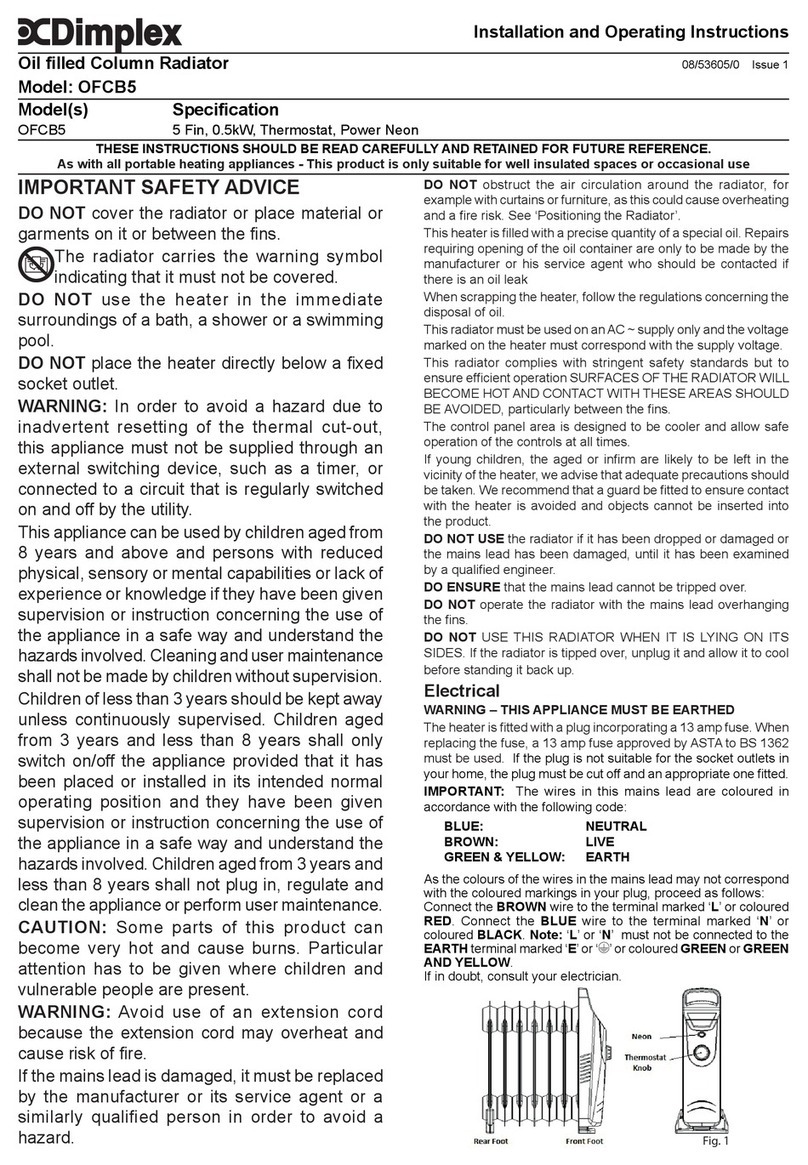
Dimplex
Dimplex OFCB5 Installation and operating instructions

Dimplex
Dimplex BLF3451 Service manual

exonda
exonda S32 operating instructions
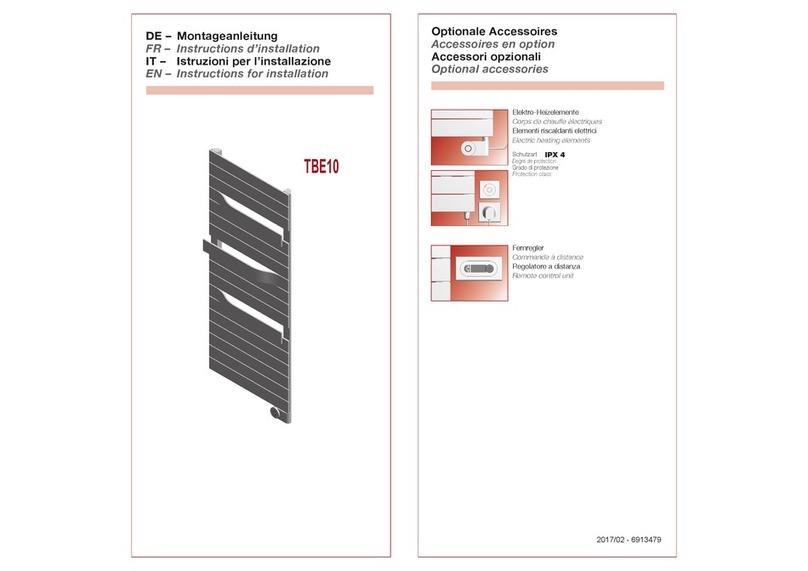
Kermi
Kermi TBE10 Instructions for installation

Rointe
Rointe Torino electric OVAL 500 instruction & installation guide

Optimus
Optimus H-7328 Instruction manual and owner's guide
